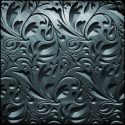Career Profile: Etchers and Engravers (French version available)

A bracelet, a ring, or etched picture can be a nice gift, especially when it is made personal. Etchers and engravers use their artistic skills to write words or draw pictures on metal, wood, rubber, or other materials. For people with artistic skills and steady hands, the job of etcher or engraver can be a good choice.
Educational requirements for people in this trade vary, but a high school diploma is usually enough to get a job. High school courses in English and mathematics can be useful, as well as any type of course that helps students learn to use their hands. Some employers might want etchers and engravers to take courses at a trade school, but not always. Taking courses in fine art, jewelry, or similar subjects can be helpful.
Besides this training, special courses in etching and engraving can be useful. In Ontario, Alberta, Nunavut, and the Northwest Territories, trade certification is available but not required. The Society of Canadian Painter-Etchers and Engravers is a good place to find information on current requirements and other questions. Getting support from other people in the trade is also useful, especially since the work can often be quite solitary.
Much of the work of an etcher or engraver is learned on the job. Some employers prefer to hire people with experience in the trade, and so getting a summer position or a part-time job in an engraving shop can be useful. Often, shopping malls have small stores where this kind of work is done. Larger stores or tourist shops might also have work. Even factories sometimes hire etchers and engravers to work with company logos and other jobs.
People in this trade need to be both creative and precise. Sometimes, customers come with exact designs that they want, but sometimes they need help with ideas. Creativity and patience can help people in this trade to work with the public. The ability to follow directions is also essential. Physically, this trade requires good eyesight with or without glasses and a steady hand. Being able to use very delicate tools is important.
As people age, they might find the work too difficult, and they might want to move to the design side of the job. Generally, salaries start at about $40,000 and can eventually reach $98,000 per year.
Normally, the work of an etcher and engraver is indoors where weather is not an issue. However, people’s backs and hands can become sore, and their eyes can become tired. Working with customers can be stressful, and it is important to be patient. Being able to work with colleagues is necessary in some cases, but being able to work alone, often for hours at a time, is also useful.
As in many other trades, keeping up to date is important. Reading about the latest design trends, tools, and other issues is essential for keeping current. Even after the initial training, some people in this trade might want to take extra courses to make sure that they know as much as possible about their work.
Working as an etcher and engraver can be a good choice for people who are both creative and attentive to detail. If that describes you, this trade might be something to consider.
Bibliography:
Best Accredited Colleges. “How to Become an Engraver: Education, Training and Career Information.” https://bestaccreditedcolleges.org/articles/how-to-become-an-engraver-education-training-and-career-information.html.
CareerOne Stop.” Etchers and Engravers.” https://www.careeronestop.org/toolkit/careers/occupations/Occupation-profile.aspx?keyword=Etchers%20and%20Engravers&onetcode=51919400&location=SAn%20Diego,%20CA&lang=en.
Edward P. Taylor Library & Archives Special Collections. “Society of Canadian Painter-Etchers and Engravers. http://atom.ago.ca/index.php/society-of-canadian-painter-etchers-and-engravers.
Glassdoor.ca. “Engraver Salaries in Canada.” https://www.glassdoor.ca/Salaries/engraver-salary-SRCH_KO0,8.htm.
Simon Fraser University. “Laser Cutting and Etching: Media and Maker Commons.” https://www.lib.sfu.ca/facilities/make-create/maker-commons/tools-spaces/laser-cutting.
Statistics Canada. “National Occupational Classification (NOC) 2011.” https://www23.statcan.gc.ca/imdb/p3VD.pl?Function=getVD&TVD=122372&CVD=122376&CPV=9472&CST=01012011&MLV=4&CLV=3.





Leave a comment!